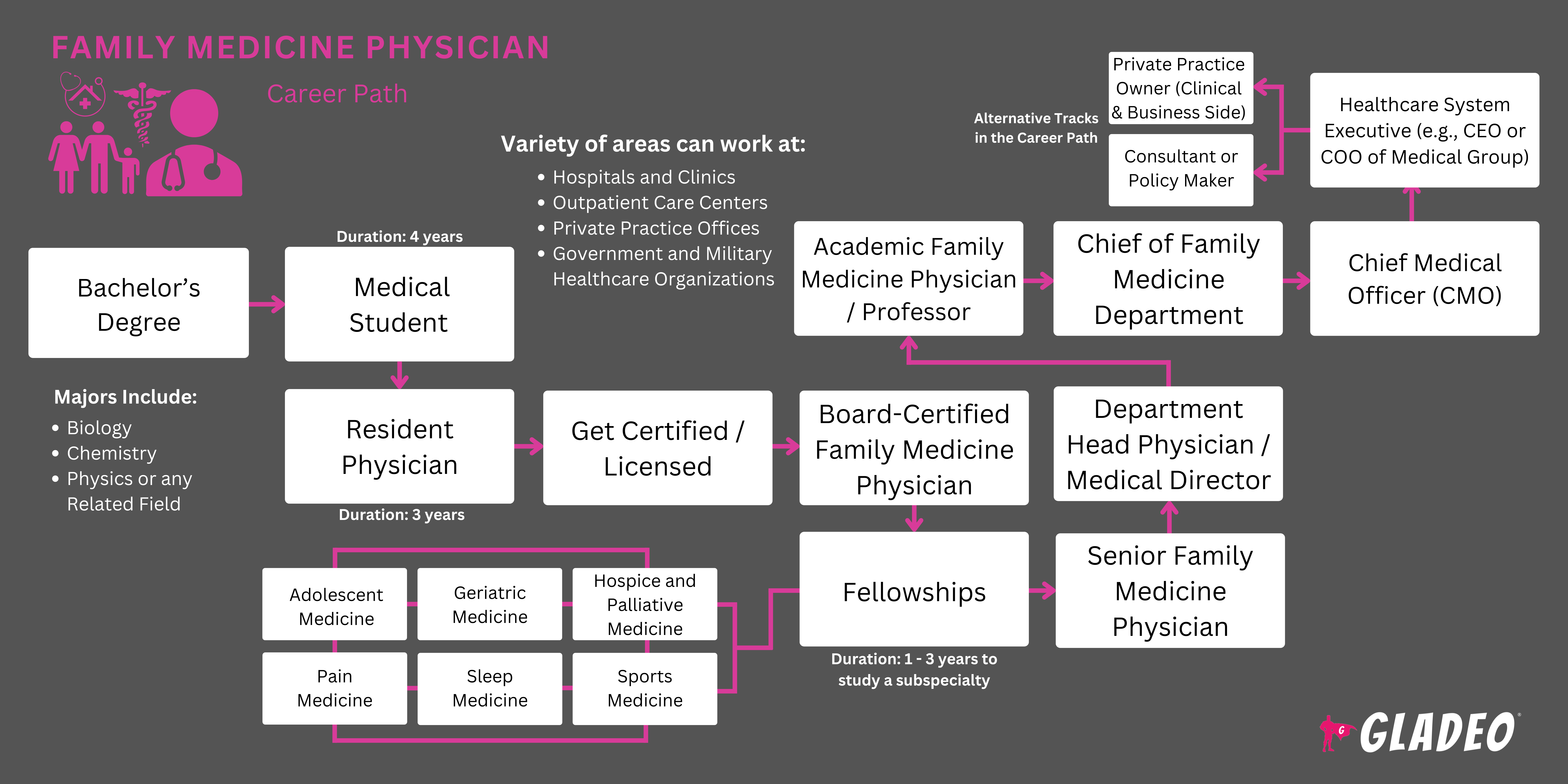聚光灯
Board Certified Family Physician, Family Medicine Physician, Family Physician, Family Practice Medical Doctor (FP MD), Family Practice Physician (FP Physician), Family Practitioner, Medical Doctor (MD), Medical Staff Physician, Physician, Primary Care Physician, General Practitioner (GP)
When we have a mild illness or injury, one of the first people we usually see is our Family Medicine Physician. Certified by the American Board of Family Medicine, these healthcare providers are trained to care for patients of all ages. They perform routine exams, assess patients’ medical signs and symptoms, and order screening tests such as blood work, X-rays, or CT scans. Based on their findings, they provide a diagnosis and treatment plan, prescribing medications as needed. They can also administer routine immunizations.
Family Medicine Physicians develop long-term relationships with their patients, seeing the same individuals for years. In fact, they often treat multiple members of the same family, hence the term “family medicine.” This continuity allows them to see patterns over time, anticipate potential issues, and offer tailored preventative care and treatment plans. They also conduct follow-ups to monitor the effectiveness of a medication or treatment.
In addition to providing primary care, Family Medicine Physicians can specialize in certain areas, too. However, when a patient’s condition requires further expertise, they refer them to advanced experts such as cardiologists, dermatologists, gastroenterologists, psychiatrists, physical therapists, surgeons, or others.
Note: Family Medicine providers are sometimes called General Practitioners (GPs), but this is no longer technically correct. In the US, Family Medicine Physicians undergo dedicated residency training, manage a wider range of conditions, and emphasize continuous and preventive care. In contrast, GPs often have less specialized training and may concentrate more on treating common or acute illnesses.
- 改善病人的健康、寿命和生活质量
- Treating existing medical problems and helping to prevent new ones
- 优厚的薪酬和福利,长期工作前景良好
- 众多的专门化机会
工作日程
Family Medicine Physicians work full-time and often overtime, depending on employer requirements or work settings. They may be on-call to handle urgent patient needs, especially in hospitals and clinics. Many operate private practices and have numerous administrative and business tasks to perform on top of their medical duties.
典型职责
- Review patient notes and vital signs from physician’s assistant or nurse
- Listen to patient explanations of their symptoms and circumstances
- Ask questions to uncover additional information
- Review patient medical records and histories
- Perform routine or specific physical examinations, such as using a stethoscope to listen to heartbeats and breathing
- Order screening tests such as blood work and diagnostic imaging such as X-rays or CT scans
- Perform simple biopsies to take tissue samples for testing
- Input data and findings into medical software to update patient charts
- Consult digital medical reference materials
- 回答病人的问题并回应关切
- Review test results when available
- Make an initial diagnosis of any illness or injury when possible
- Provide or order direct treatment (such as setting a cast for a broken bone)
- Prescribe an at-home course of treatment. Write medication prescriptions
- Discuss treatment options and instructions with family members, as needed
- Offer tips for preventative healthcare and healthy lifestyles.
- Help at-risk patients understand how to avoid developing chronic conditions like diabetes or hypertension
- Refer patients to specialist providers, as needed
- Administer routine immunizations
- Order follow-up appointments to check out patient recovery
- Respond to acute or emergency cases, as circumstances warrant
- Assist with end-of-life care planning, advance directives, and palliative care options
额外责任
- Perform routine health check-ups at least annually
- Conduct telemedicine visits and respond to patient messages via online portals, if used
- Keep up with newly-approved medicines, pharmaceutical
developments, treatments, and technologies - Work as part of a patient’s larger healthcare team to coordinate care
- Help train assistants and other team members
- Manage administrative duties or advertising campaigns related to one’s private practice
Family medicine is a specialty itself, but Family Medicine Physicians may choose a subspecialty such as:
- 青春期医学
- Geriatric Medicine
- 临终关怀和姑息医学
- Obstetrics
- Preventive Medicine
- Sleep Medicine
- Sports Medicine
软技能
- 床边礼仪
- 商业头脑和营销技能(针对私人执业者)
- 怜悯之心
- 稳重
- 可靠性
- 注重细节
- 灵活性
- 勤奋
- 手眼协调
- 诚信
- 循序渐进
- 观察者
- 病人
- 解决问题
- 建立关系
- 安全意识
- 健全的判断力
- 劲力
- 强大的沟通能力
- 教学
- 时间管理
技术技能
- 对人类生物学和生理学有深刻认识
- 有关医疗疾病和伤害的知识,以及它们的迹象和症状
- 对医疗仪器、设备和方法的了解
- 与自己的执业领域有关的专业技能
- Use of medical records software
- 熟悉其他医疗专业人员的职责
- 了解个人防护设备以及卫生和消毒的做法
- 医院和诊所
- 门诊护理中心
- 私人执业办公室
- Government and military healthcare organizations
Patients trust their Family Medicine Physicians with their health and well-being. In fact, many families have multiple family members seeing the same doctor. Thus, the job carries significant responsibilities, such as listening to patients carefully, dedicating sufficient time and attention to diagnose issues accurately, and maintaining high levels of competence and reliability.
Balancing these demands with personal life can be challenging. The ever-changing landscape of medicine requires doctors to engage in continuous learning to stay updated on the latest advancements. Those who operate their own private practices face the added pressure of managing business-related duties and costs, too.
For example, malpractice insurance is often a significant cost, running several thousand dollars per year. Doctors employed by hospitals or medical groups usually have their premiums paid, but those in private practice or smaller clinics typically shoulder this expense themselves. Private practice doctors must also pay for office rent, staffing, medical supplies, and electronic health record systems.
Family medicine is moving toward patient-centered, team-based models where care is coordinated among a multidisciplinary team. This comprehensive approach enhances the quality of care, improves patient outcomes, and optimizes resources, especially for those with chronic conditions.
As healthcare shifts to a value-based model, Family Medicine Physicians are pivotal in promoting wellness and preventing chronic diseases through patient education, screenings, early detection, and intervention. This model also incorporates lifestyle medicine, such as nutrition and mental health strategies, to address the root causes of illnesses.
The integration of technology such as telehealth is a growing trend, especially after social distancing and other restrictions implemented during the coronavirus pandemic. Beyond telemedicine, digital health tools like electronic health records, remote monitoring, and mobile apps are enhancing patient care and efficiency. AI and machine learning are also being used to assist with diagnosis and patient management.
Family Medicine Physicians may have had an aptitude for reading complex materials and been interested in biology and medicine from an early age. They could have also demonstrated compassion for others’ well-being.
需要的教育
- Family Medicine Physicians must complete extensive education and training requirements, starting with a bachelor’s degree and then working towards their Medical Doctor (MD) or a Doctor of Osteopathic Medicine (DO) at a medical school program.
- Bachelor degree majors vary, with popular pre-med majors including biology, chemistry, and biochemistry. These majors may help students to meet medical school prerequisites and to have a more competitive application.
Common undergrad courses may include anatomy and physiology, biochemistry, biology, biology labs, calculus, genetics, and organic chemistry.
医学院
- Medical school programs consist of two main phases. The first “preclinical phase” features academic courses, labs, classroom activities, plus some practical skills development. The second “clinical phase” involves consulting with patients at clinics and hospitals under supervised conditions.
- Applicants must take and pass the Medical College Admission Test (MCAT) and submit results along with their program applications.
- The MCAT is a critical element of a successful application. The test is multiple-choice and designed to assess “problem-solving, critical thinking, and knowledge of natural, behavioral, and social science concepts and principles prerequisite to the study of medicine.”
- When assessing applications, med school review boards consider each applicant’s undergraduate coursework, GPA, and MCAT scores, as well as any demonstrated personality and leadership traits and extracurricular activities involvement. The review officers also conduct formal interviews of selected applicants.
- Note, a limited number of schools feature combined undergraduate and medical programs which can make the educational route smoother. These programs tend to be very competitive to get into.
Licensure and Residency
- After graduation from medical school, graduates must complete residency programs at a clinic or hospital, serving as “interns” for the first year. Residency programs help doctors develop deeper knowledge and hands-on experience in their specialty. Family medicine residencies may last ~3 years.
- Students can study to become either Medical Doctors (MDs) or Doctors of Osteopathic Medicine (DOs).
- Per Scripps.org, “More than half of DOs practice in primary care, specializing in internal medicine, family medicine and pediatric medicine where they can develop long-term relationships with their patients. DOs generally take a more holistic approach and look beyond the physical symptoms of illness or injury. They take into account the various aspects of a patient’s life — including body, emotions, the environment, mind and spirit — to develop an individualized care plan.”
- After the first year of residency, Family Medicine Physicians should apply for state licensure, with requirements differing from state to state.
- One common requirement is passing a national exam. MDs must pass steps 1 and 2 of the U.S. Medical Licensing Examination (USMLE). DOs must pass levels 1 and 2 of the Comprehensive Osteopathic Medical Licensing Examination (COMLEX-USA).
- In addition, doctors must complete either core clerkships or additional periods of clinical instruction.
奖学金
- Family Medicine Physicians who choose a subspecialty must complete fellowship training which can take 1-3 more years. St. George’s University features an Ultimate List of Medical Specialties and Subspecialties to help understand the options. Family medicine subspecialties include:
- 青春期医学
- Geriatric Medicine
- 临终关怀和姑息医学
- Obstetrics
- Preventive Medicine
- Sleep Medicine
- Sports Medicine
Board Certification
- Board certification is technically optional, but highly recommended because many employers and insurance companies require it. It also lets patients and peers know that the physician has met rigorous standards of education, training, and expertise.
- In addition, board certification can serve as a protective measure in malpractice cases.
- Certifying boards include the American Board of Family Medicine for MDs and the American Osteopathic Board of Family Physicians for DOs.
- Note, MDs must get recertified every 10 years. DOs must get recertified every 8 years.
- They must also fulfill Maintenance of Certification requirements, such as Continuing Medical Education, quality improvement activities, and periodic knowledge assessments or other evaluations as specified by the certifying board.
- Medical schools are tough to get into, so you need to be very well-prepared! That includes knocking out your bachelor’s in a relevant major while maintaining a strong GPA.
- Schools may post the minimum GPA requirements for applicants, but keep in mind that just meeting the minimum won’t make an application competitive.
- For undergraduate schools, look for programs that are accredited and feature the rigorous foundational coursework you’ll need to succeed at med school.
- Many schools serve as “feeder schools” for popular medical schools. It’s not required to attend a feeder school, but it could be helpful.
- 考虑学费(州内/州外学费)、折扣、奖学金和授课方式(校内、在线或混合课程)。
- Review faculty bios and awards and learn what types of facilities and modern equipment the program utilizes. Also peek at the accomplishments of the alumni network!
- For medical school, check out the available options for clinical rotations, which are done at affiliated teaching hospitals, medical centers, and clinics.
- Examine the program’s acceptance rates, graduation rates, and job placement stats.
Biology is the most common major for future Family Medicine Physicians and is widely offered in universities around the nation. U.S. News’ Colleges Offering a Biology Major provides a detailed ranking of some of the best school options, but there are plenty more to choose from. The site also features a helpful page for finding the best medical schools based on your area of interest!
- Participate in school activities where you can hone your soft skills and gain leadership experience.
- Take college prep classes in high school, including anatomy, physiology, biology, chemistry, math, physics, calculus, statistics, English composition, psychology, and communications. Study hard to earn good grades so you can get accepted into a suitable pre-med undergrad program.
- Choose your undergraduate major wisely. The most common bachelor’s degree major for Family Medicine Physicians is biology, but some students major in chemistry, biochemistry, or other fields.
- Plan ahead by looking at med school requirements early! The key is ensuring you have a solid foundation for medical school with all prerequisites completed.
- Apply for pre-med jobs like home health aide, medical scribe, phlebotomist, or certified nursing assistant.
- Join medical student organizations to make friends, learn, and stay motivated! Popular options include:
- Keep a list of contacts (including phone numbers or emails) who might serve as future job references.
- Read, watch, or conduct informational interviews with Family Medicine Physicians to learn about their daily duties.
- Check out medical journal articles and video tutorials about family medicine subspecialties.
- Keep a working draft of your resume and CV.
- Learn about the specific licensure requirements for the state you plan to work in.
- Stay out of trouble so you can pass a criminal background check if required for licensure in your state.
- Develop a workout schedule so you can stay in shape and manage stress.
- Practice your interview skills before applying to medical school.
- Study hard for the MCAT with prep books and online prep courses and materials.
- Start using the resources made available by professional organizations like the American Academy of Family Physicians (AAFP), which offers an “array of information and tools designed to address your needs and help you navigate your career.”
- Note, the AAFP even has a helpful YouTube channel!

- Medical school residents receive a salary, so that could be considered one’s “first job” in this career field. Fully qualified Family Medicine Physicians earn considerably more, but a resident is a working student with an employment contract and job description!
- Review job portals such as Indeed, Glassdoor, healthcare job search sites, and career pages for clinics or hospitals you’d like to work at.
- Take note of keywords used in job postings, such as:
- Chronic Disease Management
- Diagnosis and Treatment
- 全科医学
- Health Education
- Medical Consultation
- Multidisciplinary Collaboration
- 病人护理
- Patient Counseling
- Physical Examinations
- Preventive Care
- Promote yourself on LinkedIn and keep your social media professional. Potential employers frequently screen candidates’ digital footprints.
- Get involved with professional organizations. Attend events, be a guest speaker, and network with peers!
- Check out Family Medicine Physician resumes for ideas on formatting, phrasing, and keywords.
- Talk with working doctors to learn about the types of interview questions to expect.
- Example questions might include: “How do you approach building long-term relationships with your patients and their families to ensure comprehensive, continuous care?” or “Can you describe a time when you had to manage a complex case involving multiple health issues or chronic conditions?”
- Run through several mock interviews with a friend to practice your responses.
- 面试时着装要专业。
- Share your professional goals with your supervisor and ask for mentorship on how to advance your career.
- Never stop learning about your field of expertise. Study journals, attend conferences, and take extra classes if needed.
- Get board-certified in a subspeciality that’s in demand. Also, be sure to get recertified on time, as needed.
- If a doctor forgets to get recertified, they may lose their board certification, impacting their hospital privileges, insurance network inclusion, employment opportunities, and reputation, and potentially exposing them to legal risks.
- Demonstrate top-notch leadership capabilities and patiently train and mentor younger professionals.
- Always live up to your medical oath or promise. Master your duties and bedside manner, follow all hygiene protocols, and stay up-to-date on relevant hospital or clinic policies and procedures.
- Provide exemplary service to your patients. Earn their trust—and their positive reviews!
- Patients often search for online reviews or testimonials to see what other patients have said about their experiences. Thus, the importance of patient reviews should not be underestimated.
- Consider opening a private practice or establishing a group practice.
- Relocate to an area that has more opportunities, such as a city with many hospitals and clinics.
- Per the Bureau of Labor Statistics, the states with the highest employment level for Family Medicine Physicians are California, Florida, Pennsylvania, Texas, and Ohio.
- Study manufacturer and software guides for equipment and programs you use frequently.
- Stay constantly engaged with professional organizations like the American Academy of Family Physicians to build upon industry connections
- Attend events, give speeches, apply for critical committee positions, get articles published, and actively seek to develop your professional reputation.
网站
- 美国家庭医生协会
- 美国儿科学会
- 美国骨科医学学院协会
- 美国医学专业委员会
- 美国医生专业委员会
- 美国内科医师协会
- 美国医学会
- 美国医学生协会
- 美国骨科协会
- 美国医学院协会
- 美国医学院协会-OSR
- 州医疗委员会联合会
- 国家医学考试委员会
- 全国骨科医师考试委员会
- 学生国家医学协会
- 美国医学执照考试
医学期刊
- 家庭医学年鉴》(Annals of Family Medicine
- 内科杂志》(Annals of Internal Medicine
- 家庭医生
- JAMA
- 内科杂志》(Journal of Internal Medicine
- 医学互联网研究杂志
- 美国家庭医学委员会杂志
- 自然医学
- 柳叶刀》杂志
- 新英格兰医学杂志
书籍
- Family Practice Guidelines, by Jill C. Cash MSN APN FNP-BC
- How to Be a Rock Star Doctor: The Complete Guide to Taking Back Control of Your Life and Your Profession, by Rebekah Bernard MD
- On Becoming a Doctor: The Truth about Medical School, Residency, and Beyond, by Tania Heller
- So, You Want to Be a Physician, by Edward M Goldberg
Family Medicine is just one of the numerous medical career options available. If you’re curious about exploring alternatives, check out our list of popular healthcare professions below!
- Allergist
- 麻醉师
- Cardiologist
- 注册护理助理
- 脊医
- 牙医
- Dermatologist
- Emergency Medicine Physician
- General Internal Medicine Physician
- 执业职业护士
- Neurologist
- 麻醉师护士
- 助产士
- 执业护士
- Obstetrician and Gynecologist
- Ophthalmologist
- Optometrist
- Pediatrician
- 物理治疗师
- 助理医师
- Podiatrist
- Psychiatrist
- 放射科医生
- 注册护士
- 修复护理助理
- 运动医学医生
- Surgeon
- Urologist
- 兽医
新闻联播

特色工作

在线课程和工具







